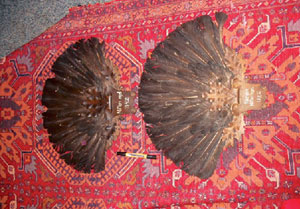 My maiden name is Siegfried and I often see Germanic Sentimentalism mixed with taxidermy. In such blatant ways I find the Germanic culture a bit frightening. J’s objects exemplify Germanic scariness.
My maiden name is Siegfried and I often see Germanic Sentimentalism mixed with taxidermy. In such blatant ways I find the Germanic culture a bit frightening. J’s objects exemplify Germanic scariness.
J sent me two German trophies made of feathers marked “Mitterriegel 19 23 IV 35,” which I take to mean a date of April 23, 1935. Mitterriegel is a section of a mountain pass, 2,000 feet above sea level, in Rosaliengebirge, a hiking region in Sauerbrunn. The other trophy says Kieneck Mitterriegel 19 14 IV 32, which I believe means April 14, 1932. In April on the mountain the temperature stays a bearable 40° F, good hiking weather. The ominous looking black feathers which fan out from a carved walnut brace below of oak leaves and acorns in relief disturb me. The cartouche holds the painted date I assume are of the hikes, or climbs. I ruled out downhill skiing because of the date.
Dark and Forbidding Feathers?
The pieces look like something used in a funeral procession, very heavy and dark. My imagination went to the feathered headpieces horses wear in a funeral cortege. Since I didn’t find anything like these on the internet, I began by identifying the feathers. Whatever bird they formerly flew on might hold the key to the symbolism of these objects. What looks dark and forbidding to my culture today might have read as something different then.
I discovered the feathers are stork, and made the connection that storks migrate through Europe. Knowing Germans love their wildlife, I learned the symbolism of these two trophies is anything but dark. These trophy fans, meant to hang on your trophy room walls, seem entirely out of place in hiking memorabilia. But the Mitterriegel is a mountain meadow on the path of the Great Stork Route, I found, proving in part, my hypothesis: these commemorate a pilgrimage to see the first Spring Storks.
Storks part of German mythology since the Middle Age
When buildings became high enough for a male stork to build a nest on citizens considered the birds good luck for childbaring. German couples hoping for a child might build a platform on their chimney to encourage nesting. The mountain meadow, Mitterriegel, today listed on the German Stork Route, was a destination in the spring for the migration of the great storks from Africa to Central Europe. Since these birds have a mythological reputation as the bringer of babies, they’re respected. I hope somebody found these feathers lying on the Germanic ground, but something tells me that might not be the case. Makes sense that German hikers in the 1920’s and 30’s welcomed the sight of hundreds of migrating pairs flying over the mountain to this meadow in the spring, and wanted to take home a memento of their pilgrimage.
Storks are majestic birds, long necks and bodies of pure white with iridescent black wing feathers, almost voiceless or songless, communicating by clattering the bill. They’re carnivores and keep the snake and vermin population down, loving to live on rooftops, in pairs. In Germany, this meadow on the Stork Route is part of what is today the UNESCO Biosphere Reserve, so although once considered endangered, the present German stork population is healthy. Storks mate for life and live into their 30’s, so I imagine the same hiker returning to this meadow in 1932 and in 1935, both times in April, migrating season, to see if he recognized any of his fowl friends.
Judging by the lack of information about these trophies, this pair is rare. And of course, feathers don’t last forever and someone must have treasured these trophies. I put the value on these at $100 each. I am relieved to find they’re not for a funereal but a celebration of Spring. That gives me a little comfort in my German heritage. After all, my ancestors wore pig bristles on their Alpine hats.